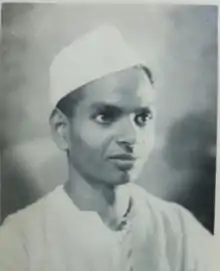Prabhudayal Vidyarthi
Prabhudayal Vidyarthi (1925–1977), aka Prabhu Dayal Vidyarthi, was an Indian independence activist, Gandhian, writer, social worker and politician. He heard Thakkar Bapa's public address, spreading Mahatma Gandhi's quest of "FREE INDIA" in 1935, left home aged barely 10 years, in search of Azadi, and later become a close aide of Mahatma Gandhi.[1] He followed Thakkar Bapa from Uska, in siddharthnagar district, to meet Gandhiji, who was perplexed to see such a young boy wanting to participate in Indian freedom Struggle and allowed him in at 'Segaon', which later come to be known as Sevagram, and personally taught him.
Prabhudayal Vidyarthi | |
|---|---|
 | |
| Born | 1925 Jogiya Udaipur, Siddarthnagar, Uttar Pradesh |
| Died | 7 September 1977 Lucknow, UP |
| Nationality | Indian |
| Spouse(s) | Kamla (also a politician) |
| Children | Two daughters |
Vidyarthi actively participated in Quit India Movement , and traveled widely, details of same are stated as "Apni Baat".[2][3] He was asked to surrender by Gandhi and was finally arrested in 1942 at Sevagram, Wardha by the British at the outset of the Quit India Movement.[1] He was immediately put in an isolation cell,questioned and tortured because of his close association with Gandhi. This was taken up with British Govt by Gandhiji on his release when he came back to Sevagram in dilapidated condition, as detailed in Gandhi's correspondence with British, Page 371 letter no 686, LETTER TO SIR EVAN M. JENKINS[4] Fact that he was tortured at Delhi was vehemently denied by the British, However they had admitted that torture methods,as described by Prabhudayal were used. Gandhiji had taken up only two cases with British, the other being Ram Manohar Lohia's case. British however relied more on testimony of Devdas than Prabhudayal to close the case even though Devdas was never arrested with Prabhudayal Vidyarthi. The case is discussed in detail in book "South Asian Governmentalities",page 126 onwards, edited by Stephen Legg, Deana Heath, which must be read with Mahatma Gandhi's letter exposing torture of Indian Freedom Fighters under British rule[5][4][6] A postcard was issued by Sevagram Ashram to honour his arrest. He wrote his first book on Gandhi in his jail during Quit India Movement
After India's independence from British rule, Prabhudayal returned to his village and started working with local villagers at the behest of Gandhi.[7] He convinced local zamindars (landlords) to help farmers get their land back. Many attempts to kill him were made as this did not go well with zamindars. In 1951-52, Jawaharlal Nehru asked him to contest in the first Indian General Elections.
He was the youngest member of Sevagram Wardha. He was also the youngest person elected to the Legislative Assembly of Uttar Pradesh in the first Indian general election.[1] He is widely known as "Purvanchal ke Gandhi" as he was the only person from Purvanchal (Eastern UP), to have lived with Gandhi. He returned to Purvanchal only after India had attained freedom.
He died, aged 52, on 7 September 1977, due to heart failure at Lucknow, Uttar Pradesh.
Work
Vidyarthi wrote many articles and books on Gandhi, the last being Devdoot Gandhi.[8][9][10] His book "Gandhi Amrit Vani" is widely read and freely available online on different portals.[2] He also wrote a book on Mahadev Desai, assistant to Gandhi, named Bapu ke Mahadev and Sevagram based on the Ashram life and Mahapurusho ki jeevan jhaki (महापुरुषों की जीवन झाँकी) available on Gandhi Heritage Portal[11] and Deenbandhu ko Shraddhajaliyan(दीनबन्धु को श्रद्धांजलियाँ)[12]
His work was mainly published by The Pustak Bhandar. His articles on general topics would regularly appear in The Hindu, Harijan, Balsakha, and other publications. He also did some translation work for C. F. Andrews. His work can be found in CIET archives and the National Library, New Delhi.[13][14][15]
"Banganga Barrage" and "Banganga Canal Major Irrigation Project" (1953–56) were his initial contribution to help the farmers in the area. "Banganga Canal Major Irrigation Project" was completed in three years. A 45 km canal was constructed to irrigate 23,000 acres of land, in conjunction with other extensive public work campaign resulting in construction of barrage and roads to connect villages etc. immediately after Independence. "Banganga Barrage" is a serene place and is known in his name as a tribute to him.[16]
Recognition
A postcard with his picture was issued to honor him immediately by Sevagram, after his arrest in connection with "Quit India Movement".
The bridge on Farenda Naugarh-Barhni Shravasti Road, Siddharth Nagar, UP is named "Prabhu Dayal Vidyarthi Van Ganga Bridge" to honour his memory.[17]
Jogia Pakdi Marg in Siddarth Nagar was named after Freedom Fighter "Vidyrthi" Prabhudayal[18]
A book "Purvanchal ke Gandhi Prabhudayal Vidayarthi" by Avinash Kumar Azad, was launched in "Kapilvastu Festival", Siddharth Nagar. [19][20][21]
Another book "Gandhi ke Vidyarthi" was compiled by Mrs Kamla Sahni giving insight into life of Freedom Fighter Prabhudayal Vidyarthi[3]
Prabhudayal Vidyarthi is still fondly remembered by people at his native place.[16][22] [23][24] [25][26]
References
- Pandey, Jeetendra (14 November 2014). "Chacha Nehru Ki Bhanti Bapu Ko Pyare Thay Vidhyarthi". Children Day Special-Bachche Man Ke Sachche. epaper.jagran.com. Jagran, Gorakhpur. Retrieved 9 February 2015.
- https://archive.org/details/in.ernet.dli.2015.348676
- https://www.snapdeal.com/product/gandhi-ke-vidyarthi-prabhudayal-by/640600476219
- https://www.gandhiashramsevagram.org/gandhi-literature/mahatma-gandhi-collected-works-volume-88.pdf
- https://books.google.co.in/books?
- https://www.cambridge.org/core/books/south-asian-governmentalities/40CE52065E18381F2EE503015FE9CE0B
- Tushar A. Gandhi (1 January 2007). "Let's Kill Gandhi !": A Chronicle of His Last Days, the Conspiracy, Murder, Investigation, and Trial. Rupa & Company. pp. 90–. ISBN 978-81-291-1094-7. Retrieved 9 February 2015.
- https://www.gandhiheritageportal.org/hi/ghp_booksection_detail/MTAwLTc3NC0z#page/1/mode/2up
- https://epustakalay.com/book/62292-devdoot-gandhi-by-prabhu-dayal-vidyarthi/
- Book Devdoot Gandhi by Prabhudayal Vidyanidhi https://archive.org/details/in.ernet.dli.2015.321782
- https://www.gandhiheritageportal.org/hi/fundamental_workdetail/NjUtMTk4#page/1/mode/2up
- https://www.gandhiheritageportal.org/hi/ghp_booksection_detail/MTAwLTQxOS0z#page/1/mode/2up
- Bibliographic Detail. Call No. H 181 ec 94.8. Author, Andrews, C. F.. Title, Dinabandhu ko sradhanjaliyam / C. F. Andrews ; edited by Prabhudayal Vidyarthi.
- http://ciet.nic.in/archive_children_litre1.php?recordID=baa
- Marwari Library marwarilibrary.com/LibraryBook.aspx?_bt=&_au...Author :Sanklankarta Prabhu Dayal Vidyarthi Catalogue No.:24.139. Pravesh No.:12398. Category:Jiwanis.
- http://www.manvadhikarmedia.in/state/uttar-pradesh/%E0%A4%AE%E0%A4%B9%E0%A4%BE%E0%A4%A4%E0%A5%8D%E0%A4%AE%E0%A4%BE-%E0%A4%97%E0%A4%BE%E0%A4%82%E0%A4%A7%E0%A5%80-%E0%A4%95%E0%A5%87-%E0%A4%B6%E0%A4%BF%E0%A4%B7%E0%A5%8D%E0%A4%AF-%E0%A4%B8%E0%A5%8D/
- https://indiankanoon.org/doc/1963826/
- https://www.jagran.com/uttar-pradesh/sidharth-nagar-found-respect-streetstreet-student-name-18241179.html
- https://apnasiddharthnagar.com/prabhu-dayal-vidhyarthi-book/
- https://www.indiatvno1.com/2018/12/blog-post_18.html
- http://www.doordarshantv.com/2018/12/blog-post_39.html
- http://kapilvastupost.com/prabhu-dayal-ki-punya-tithi-manai-gaee-sdr/
- https://www.jagran.com/uttar-pradesh/sidharth-nagar-sp-meeting-18707883.html
- http://newsfoxpost.com/mainNewsDetail.aspx?id=10019
- https://circle.page/post/1307766
- http://www.dainikvistar.com/NewsDetails.aspx?I=794